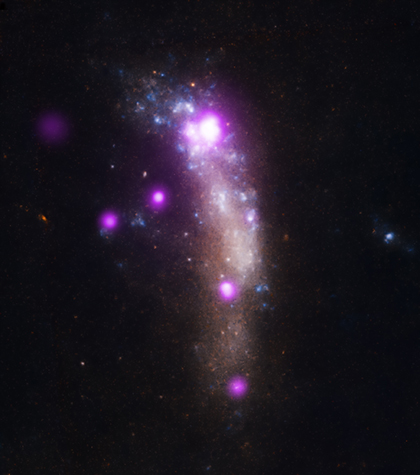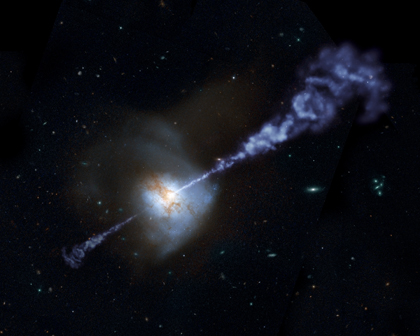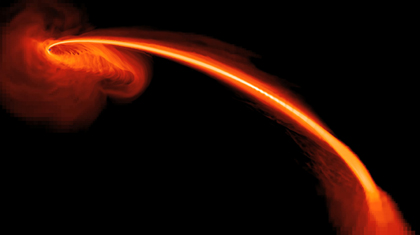A Pinwheel in Many Colors
This image of the Pinwheel Galaxy, or also known as M101, combines data in the infrared, visible, ultraviolet and X-rays from four of NASA's space-based telescopes. This multi-spectral view shows that both young and old stars are evenly distributed along M101's tightly-wound spiral arms. Such composite images allow astronomers to see how features in one part of the spectrum match up with those seen in other parts. It is like seeing with a regular camera, an ultraviolet camera, night-vision goggles and X-ray vision, all at the same time.
The Unexpected: Supernova Remnants and Neutron Stars
What has Chandra found (or not found) during the course of its mission in the important area of exploded stars and what they leave behind? Find out in this post in "The Unexpected" series.
Expected and Detected:
As anticipated, high-resolution X-ray images have provided new insight into the supernova process, the effect supernova shock waves have on the surrounding interstellar gas, the acceleration of particles by rotating neutron stars, and enabled the discovery of many stellar-mass black holes. More information:
https://www.chandra.harvard.edu/photo/2009/crab/
Updated Chandra Web Site
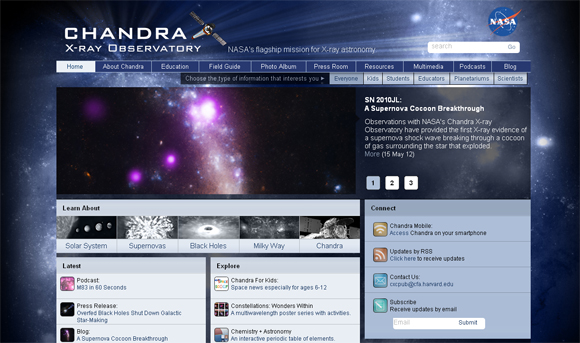
We have refreshed the Chandra web site to a content "portal" format. Let us know what you think about the changes https://chandra.si.edu
A Supernova Cocoon Breakthrough
Observations with NASA's Chandra X-ray Observatory have provided the first X-ray evidence of a supernova shock wave breaking through a cocoon of gas surrounding the star that exploded. This discovery may help astronomers understand why some supernovas are much more powerful than others.
Overfed Black Holes Shut Down Galactic Star-Making
A new study has shown that galaxies with the most powerful, active, supermassive black holes at their cores produce fewer stars than galaxies with less active black holes. Researchers compared infrared readings from the Hershel Space Observatory with X-rays streaming from the active central black holes in a survey of 65 galaxies, measured by NASA's Chandra X-ray Observatory.
The Unexpected: Normal Stars
Here's our next installation in our occasional series on the Chandra blog called "The Unexpected." These posts will take a look at some of the biggest surprises (and expected discoveries) made by Chandra so far in its mission. Today's topic is "normal stars," which is what astronomers call stars that are similar to our Sun.
Expected and Detected:
X-ray emission from the outer atmospheres, or coronas, of stars of almost every type: young and old, large and small.
Black Hole Caught Red-handed in a Stellar Homicide
This computer-simulated image shows gas from a star that is ripped apart by tidal forces as it falls into a black hole. Some of the gas also is being ejected at high speeds into space.
A Funny Thing Happened While Waiting for the Next Supernova in M83
William Blair is an astrophysicist and research professor at The Johns Hopkins University in Baltimore, Md. He penned this blog post to help explain the excitement -- and challenges -- involved with getting a handle on the mysterious ULX (ultraluminous X-ray source) he and his colleagues discovered in the spiral galaxy M83.
The spiral galaxy M83, also known as the Southern Pinwheel Galaxy, is an amazing gift of nature. At 15 million light years away, it is actually one of the closer galaxies (only 7-8 times more distant than the Andromeda galaxy), but it appears as almost exactly face-on, giving earthlings a fantastic view of its beautiful spiral arms and active star-forming nucleus. M83 has generated six observed supernovas since 1923, but the last one seen was in 1983. We are overdue for a new supernova!
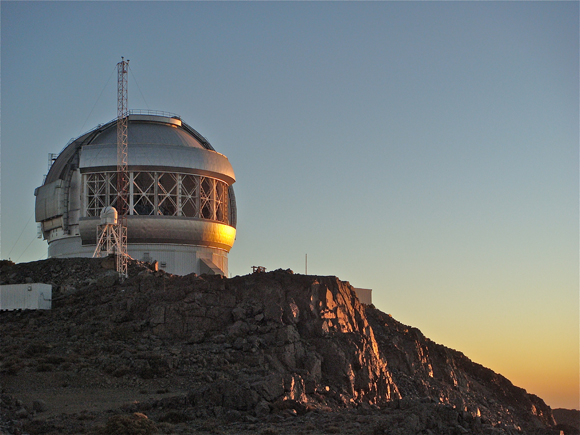
Gemini Observatory.
Because of all the star formation and supernova activity in M83, we also expect there to be a lot of X-ray binary stars and supernova remnants—the expanding leftovers from old supernovas that stay visible for several tens of thousands of years after the supernova fades. By tying multiwavelength observations of M83 together, my colleagues and I hope to learn a lot about the interplay between the stars and the gas, and how they impact the entire galaxy.
Welcome Home, Shuttle Discovery
This morning, the Space Shuttle Discovery touched down from its final flight – a journey from the Kennedy Space Center in Florida to Washington, DC. Discovery will eventually be on display at the Smithsonian's Udvar-Hazy Center near the Dulles airport.
Chandra's own Roger Brissenden was on hand in Washington, DC, for today's event. Chandra has connections to this event on both the NASA and the Smithsonian sides.
A New View of the Tarantula Nebula
To celebrate its 22nd anniversary in orbit, the Hubble Space Telescope has released a dramatic new image of the star-forming region 30 Doradus, also known as the Tarantula Nebula because its glowing filaments resemble spider legs. A new image from all three of NASA's Great Observatories - Chandra, Hubble, and Spitzer - has also been created to mark the event.



